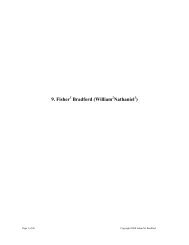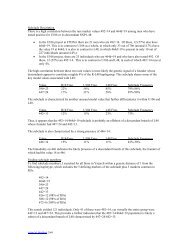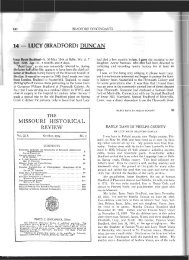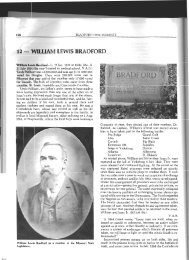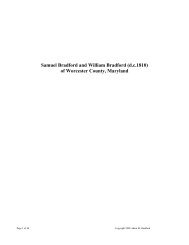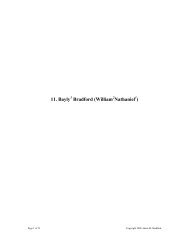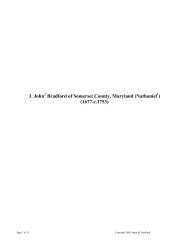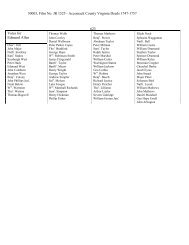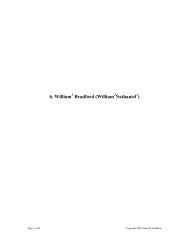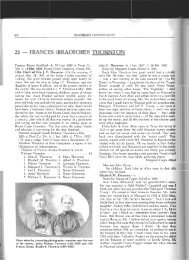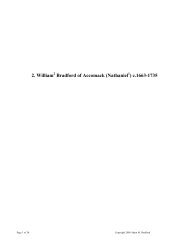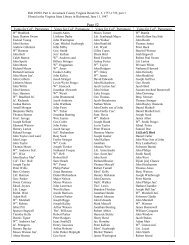1. Nathaniel Bradford of Accomack County, Virginia - Lower ...
1. Nathaniel Bradford of Accomack County, Virginia - Lower ...
1. Nathaniel Bradford of Accomack County, Virginia - Lower ...
Create successful ePaper yourself
Turn your PDF publications into a flip-book with our unique Google optimized e-Paper software.
Five years later, in 1669, <strong>Nathaniel</strong> had 5 tithables in his household, which actually placed him among an<br />
elite 10% <strong>of</strong> individuals in <strong>Accomack</strong> with households containing 5 or more tithable individuals.<br />
1669 172<br />
1 with 21 Ann T<strong>of</strong>t [head <strong>of</strong> one <strong>of</strong> Col. Scarburgh’s plantations]<br />
1 with 19 Col. Edm. Scarburgh<br />
1 with 10 Capt. Edm. Bowman<br />
1 with 8 Hugh Yeo<br />
1 with 7 Henry Smith<br />
5 with 6 Tho. Browne, Robt. Huitt, Geo. Parker, Maj. Tilney, Capt. West<br />
8 with 5 incl. <strong>Nathaniel</strong><br />
19 with 4<br />
28 with 3<br />
35 with 2<br />
90 with 1<br />
In 1671, the year his household underwent the 50% increase in tithable individuals, <strong>Nathaniel</strong> <strong>Bradford</strong> was<br />
among the top 5% <strong>of</strong> individuals in <strong>Accomack</strong> in terms <strong>of</strong> size <strong>of</strong> household. He and only 5 others, out <strong>of</strong> a<br />
total <strong>of</strong> 221 individuals on the tax list, had households with 9 or more individuals. This exclusivity becomes<br />
even more significant when one considers that none <strong>of</strong> <strong>Nathaniel</strong>’s sons were <strong>of</strong> taxable age at this time. In<br />
fact, <strong>Nathaniel</strong>’s household was larger than that <strong>of</strong> several <strong>of</strong> the county’s justices <strong>of</strong> the peace.<br />
1671 173<br />
1 with 40 Col. Scarburgh’s<br />
1 with 14 Devorax Brown<br />
1 with 11 Capt. Jenifer<br />
1 with 10 Capt. Jno. West<br />
2 with 9 <strong>Nathaniel</strong> <strong>Bradford</strong> & Charles Scarburgh<br />
1 with 8 Capt. Edmd. Bowman<br />
2 with 7 Maj. Geo. Parker & Mr. Hugh Yeo<br />
5 with 6<br />
10 with 5<br />
13 with 4<br />
22 with 3<br />
59 with 2<br />
103 with 1<br />
In 1671, and thereafter until his death, <strong>Nathaniel</strong> remained in about the top 5 th percentile <strong>of</strong> individuals in<br />
<strong>Accomack</strong> <strong>County</strong> in terms <strong>of</strong> size <strong>of</strong> household. In every year Colonel Edmund Scarburgh was alive his<br />
household far outstripped all others in terms <strong>of</strong> size. In 1671, the second ranked individual in terms <strong>of</strong><br />
household size, Devorax Brown, had only 3 more tithables than the third ranked individual, Capt. Daniel<br />
Jenifer. Yet Scarburgh had 26 more individuals in his household than Brown - another indication <strong>of</strong> the<br />
power, wealth and influence he wielded in <strong>Accomack</strong> <strong>County</strong>.<br />
Discussion <strong>of</strong> the tithable lists for the remainder <strong>of</strong> <strong>Nathaniel</strong>’s life will be reserved for later, since they<br />
take on a different significance based on what was occurring in his household at that time. Suffice it to say<br />
that by the 1670s <strong>Nathaniel</strong> may be ranked among the elite <strong>of</strong> <strong>Accomack</strong> <strong>County</strong> in terms <strong>of</strong> the number <strong>of</strong><br />
dependants on his plantation.<br />
* * * * *<br />
Consolidation <strong>of</strong> <strong>Bradford</strong>’s Neck and Addition to Holdings<br />
In 1672 <strong>Nathaniel</strong> had a patent reissued for the whole <strong>of</strong> his land at Matchapungo, including the 1000 acres<br />
originally patented in 1662, the 1400 acres patented in 1664 and the 400 acres added in 1667. 174 It appears<br />
that <strong>Nathaniel</strong> had failed to plant or build houses on both the 1000-acre tract and the 400-acre tract, since<br />
they were listed as deserted when the patent was reissued and <strong>Nathaniel</strong> had to supply 28 new headrights to<br />
lay claim to them again. In 1672, these three separate tracts were consolidated into a single plantation <strong>of</strong><br />
Page 34 <strong>of</strong> 74 Copyright 2008 Adam M. <strong>Bradford</strong>




